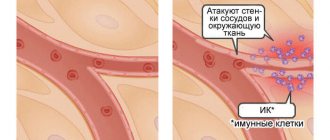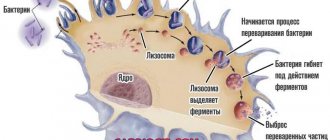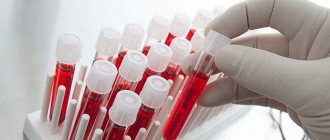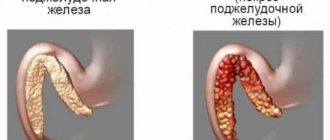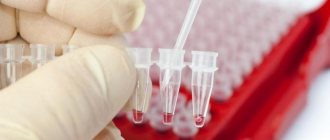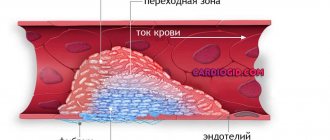ESR or erythrocyte sedimentation rate indicates an imbalance of blood proteins, which can result from cell destruction as a result of many pathological conditions. In case of cancer, a change in ESR is not at all necessary, but in some clinical situations, an acceleration or deceleration of the rate of fall of red blood cells may occur.
- ESR: what is it?
- ESR norm
- ESR indicators in oncology
- Table of ESR indicators for oncology in men and women
- Preparation for analysis
- How to get tested
ESR: what is it?
ESR and ROE - erythrocyte sedimentation reaction are the same thing, but the latter abbreviation is considered outdated. ESR shows the intensity of red blood cell aggregation followed by their sedimentation to the bottom.
The clumping of red blood cells is enhanced in the presence of the protein fibrinogen, which is involved in the formation of blood clots and is normally practically absent in plasma. A decrease in the largest fraction of proteins - albumin and an increase in numerous protein fractions of globulins - gamma, beta and alpha changes the ESR towards an increase.
The sedimentation rate will certainly change if the erythrocyte has an abnormal shape and non-standard size, which is typical for anemia of various etiologies, including those caused by complications of chemotherapy.
Any pathological process - infection, inflammation, tumor, especially a malignant blood disease, affects the ratio of blood proteins and, of course, can shift the indicator in one direction or another.
Classification
There are no clear digital gradations for dividing the increase in ESR by degree. Conventionally, moderate and high degrees are distinguished. According to the mechanism of occurrence they distinguish:
- True increase in ESR
. The cause is various inflammations, infectious, and oncological pathologies. Develops as a result of dysproteinemia, which increases erythrocyte aggregation. - False increase in ESR
. False acceleration of ESR is observed in anemia, azotemia, alkalosis, and high blood cholesterol levels. The cause of this phenomenon is various pathological processes in which the ESR increases due to changes in the number or shape of red blood cells, the protein-lipid composition of plasma, a shift in blood pH, and the presence of other chemical compounds.
ESR norm
For analysis, blood is taken from a finger or a vein, and the study itself is performed using the Panchenkov or Westergren method. Despite some differences in the methods, the values of the indicators in the area of normal values are almost the same, as well as the units of measurement - millimeter per hour.
Normal interval rates of subsidence rates have been determined for all age groups of children; for adults there is only a gender norm without taking into account age, but it is known that over the years of life the rate slightly accelerates. In women, normal values are higher than in men: from 2 to 15 mm per hour versus an interval of 1 to 10 mm.
Table - Normal ESR values.
| Patient group | ESR values (mm/h) | ||
| Md Panchenkova | Westergren MD | ||
| Children under 11 years old | 4-11 | 2-10 | |
| Men | up to 50 years | 1-10 | 2-15 |
| after 50 years | 2-20 | ||
| Women | up to 50 years | 2-15 | 2-20 |
| after 50 years | 2-30 | ||
The higher value of female ESR is explained by the lower density of red blood cells per milliliter of blood, which allows them to fall faster, similar to the higher speed of a car on an open highway and the inevitable decline in heavy traffic.
During pregnancy, or rather from the second half, ESR increases, reaching 50-60 mm per hour. After childbirth, the balance of protein fractions and sex hormones, which are proteins, as well as plasma volume gradually return to normal and the rate of fall of blood cells stabilizes.
The erythrocyte sedimentation rate responds to food intake, so blood tests are taken on an empty stomach. The rate of red blood cell sediment formation is sensitive to some medications and physical activity, even to the duration of the summer heat period, so normal values are given with a spread, where the maximum value is several times higher than the minimum value.
Every twentieth healthy adult has his own ESR standard, deviating from the generally accepted standard.
If any abnormalities from the norm appear in the blood test of a cancer patient, and not just changes in ESR, you need to consult with an oncologist; an examination may be required. Our Clinic specialists are ready to help and find the root cause.
Book a consultation 24 hours a day
+7+7+78
Reasons for the increase
Factors that increase the indicator are almost always pathogenic. Although, there are exceptions.
Infectious inflammatory processes
Various forms of septic conditions. It can be anything.
Three groups can be distinguished:
- Bacterial lesions.
- Disorders of the body under the influence of viral agents. For example, herpes, influenza, adenovirus and others.
- Fungal disorders. They are relatively rare.
The symptoms of the disorder depend on the specific case. As a rule, the following problems are always present:
- Increase in body temperature. Up to levels from 7 to 40 degrees and even higher. It all depends on the specific pathological process.
- Headaches, discomfort of other localization.
- Weakness, drowsiness. Signs of general intoxication of the body.
For the rest, you need to build on a specific diagnosis.
Treatment is specific, depending on the condition:
- Antibiotics are prescribed in loading doses.
- Antiviral drugs help fight infections.
- Fungicides fight fungi.
- To lower the temperature, antipyretic and anti-inflammatory drugs of non-steroidal origin are used.
Next - depending on the situation. The issue should be resolved by a specialized specialist or, at a minimum, a therapist.
Autoimmune inflammatory processes
Another kind of pathological condition. In this case, we are talking about a nonseptic lesion. That is, infectious agents are not involved here. The body itself reacts to a non-existent threat.
The immune system begins to attack the cells of its own body, the host. The process becomes cyclical and practically never ends if you don’t fight it. All that remains is to correct the symptoms.
Among the most common forms of the disorder:
- Rheumatoid arthritis. Inflammatory process of the joints. Usually affects large structures. Be it knees, elbows or hips. Occurs in patients of different ages.
- Rheumatism. A destructive process affecting the myocardium. Characterized by systematic relapses and exacerbations.
- Lupus erythematosus. Generalized autoimmune inflammation.
- Hashimoto's thyroiditis. Damage to the thyroid gland. It occurs relatively rarely, but poses a huge danger to the body.
Treatment depends on the specific pathological process. ROS (erythrocyte sedimentation reaction) normalizes on its own, some time after the main therapy.
Glucocorticoids are prescribed. Prednisolone and more powerful analogues, if required. If ineffective, immunosuppressants are used.
They reduce the intensity of the reaction of the defense forces. That those that other drugs cannot be taken for a long time. Too dangerous for your health. Lots of side effects.
Oncological processes
Cancer almost immediately leads to an increase in ESR in women and not only. The more advanced the condition, the worse the health situation.
The speed increases gradually, not rapidly. Therefore, a violation can go unnoticed for a long time. It makes sense to conduct a thorough diagnosis in addition to a general blood test.
It doesn’t matter where exactly the tumor is located. What is more important is what stage it is at.
Symptoms of advanced cancer are specific. There are always common signs:
- Increase in body temperature. Due to the disintegration of the tumor and poisoning of the whole body.
- Weakness, drowsiness.
- Abnormally thin. Weight loss. Related to the same thing.
Recovery is carried out under the supervision of an oncologist. The goal is to remove the tumor. It is solved surgically by excising the abnormal structure.
Then, if appropriate, radiation and chemotherapy are prescribed to eliminate any remaining neoplasia and prevent it from growing again.
After quality treatment, the ESR decreases. Normalization is temporary until a relapse occurs (if there is one at all).
Endocrine diseases
The above pathologies are especially common. As for hormonal imbalances, this is a relatively rare cause of changes in ESR.
However, a woman’s body is more sensitive to fluctuations in the level of specific substances. Therefore, the reason is more common than in men.
Thyroid pathologies can cause disturbances in sedimentation rate. Among them are qualitatively different:
- Thyrotoxicosis. When there are too many substances. T3 and T4 are produced in excess and poison the entire body.
- Hypothyroidism. The opposite phenomenon. In this case, the concentration of hormones decreases.
Symptoms of pathological processes will be diametrically opposite.
For hyperthyroidism, this is:
- Loss of body weight.
- Protruding eyes.
- Weakness.
- Insomnia.
- Blood pressure surges.
- Cardiac dysfunction, tachycardia.
With insufficient production of substances, everything is exactly the opposite.
Treatment is carried out under the supervision of an endocrinologist. To correct the increased amount of T3 and T4, iodine preparations and a diet low in this element are prescribed.
The reverse process is treated with substitutes, artificial forms of the hormone.
The task is complex, but can be solved under the guidance of a competent doctor. It may well be that secondary changes will develop. For example, a decrease in estrogen concentration.
In such a situation, other disorders also need to be treated. Otherwise, they themselves can lead to an increase in ESR. Here you need the help of an endocrinologist and gynecologist.
Poisoning, intoxication
Some toxic substances can lead to aggregation of red blood cells, their sticking together and death.
These include, for example:
- Salts of lead and other heavy metals.
- Vapors of chemical compounds, acids.
- Organic poisonous components.
In any case, urgent treatment in a hospital is needed. It is quite difficult to encounter poisons in natural conditions.
Violations occur especially often when:
- Working in hazardous industries. If a woman performs functions directly in the workshop.
- Consumption of food that has been fertilized with harmful fertilizers.
- Poisoning often occurs when using mushrooms that grow in questionable places. For example, in the area of disposal of lamps, waste, garbage.
Be that as it may, the patient is transported to the hospital. It is necessary to detoxify and restore the functioning of the body.
The ESR norm in women is restored within several weeks to an adequate 3-15 mm/h, and by this indicator one can judge the dynamics of the process and the quality of therapy.
Some forms of metabolic disorders
They should not be confused with endocrine disorders. Here we are talking about problems with metabolism.
Among the possible pathological processes:
- Amyloidosis. Deposition of a specific compound in tissues.
- Hypercholesterolemia. Especially its family types, when too many fats circulate in the body and they are not excreted normally.
There are other forms of pathological processes. The point is that they lead to a rapid increase in ESR rates. You need to fight the primary diagnosis in order to cope with the disorder.
Therapy is carried out under the supervision of endocrinologists. The course depends on the specific diagnosis.
Use of certain drugs
From the point of view of the female body, estrogens are especially dangerous. You can find synthetic hormones in oral contraceptives.
Birth control pills are very difficult medications. They should be taken with caution and strictly in the prescribed dosage. Not for long, so as not to provoke violations.
Of course, few people follow these recommendations. As a result, a group of symptoms develops, in addition to an increase in ESR:
- Sudden changes in body weight. Usually, the weight increases.
- Mental disorders. Emotional instability, depression, irritability and aggressiveness. Other changes. Need help from a psychotherapist.
- Menstrual irregularities.
- Reproductive disorders. It becomes impossible to conceive a child. This will continue until the hormones return to normal.
Changes in ESR are indicative, but not the biggest problem in the context of the situation. Treatment is carried out by endocrinologists.
The drug is discontinued and replacement therapy is prescribed.
Attention:
Hormonal levels, as a rule, do not return to normal on their own; this is very rare.
ESR indicators in oncology
Erythrocyte sedimentation rate is a nonspecific marker, since it changes with any pathology. ESR is only evidence of trouble and the release of “extra” proteins into the blood during tissue breakdown, insufficient synthesis of albumin due to impaired liver or hemoglobin function, as well as changes in the structure of the blood cell itself during anemia.
For a long time, in the majority of those suffering from a malignant neoplasm, including those at the metastatic stage, the blood picture can be absolutely normal. The exception is blood diseases accompanied by the synthesis of pathological proteins - paraproteins, which occurs in myeloma and some malignant lymphomas.
ESR may increase in the following clinical situations:
- disintegration of a cancer tumor, when its central part is deprived of nutrition, forming an area of necrosis, and the destroyed cells enter the bloodstream;
- the addition of inflammation along the periphery of the cancer node, which often accompanies metastases in the lung or primary lung cancer;
- disturbances in protein synthesis in the liver affected by metastases;
- loss of proteins with frequent removal of ascitic or pleural fluid;
- malabsorption disorders due to a malignant tumor of the gastrointestinal tract or removal of a large volume of the stomach and intestines;
- disturbances in the synthesis of the hormone erythropoietin by the kidneys due to the toxic effects of chemotherapy drugs;
- myocardial damage due to certain cytostatics;
- development of anorexia-cachexia syndrome in the terminal stage of the disease.
A decrease in ESR in a cancer patient is possible:
- when red blood cells are deformed as a result of the use of platinum derivatives;
- with jaundice - a complication of pancreatic cancer;
- dehydration as a result of severe vomiting, especially during hot periods;
- progression of failure due to tumor damage to the liver;
- severe pulmonary heart failure with cancerous pleurisy or advanced lung cancer.
A change in ESR in a cancer patient is not a mandatory characteristic of cancer and does not reflect the course of the malignant process, but always indicates clinical distress. In each case of a change in the analysis, it is necessary to seriously understand; it is not at all necessary that this change is a sign of cancer progression.
Characteristic
Red blood cells are blood cells whose main function is to provide the tissue structure with oxygen. The secondary function of red cells is maintaining the acid-base balance and participating in the lipid process.
The term ROE
To determine ESR, a special anticoagulant (a substance that prevents the clotting process) is used. Afterwards, it is placed in a medical test tube (only vertically), for no more than sixty minutes. This manipulation is carried out so that erythrocyte sedimentation occurs.
- ESR in rheumatoid arthritis - Orthopedist.info
Reference! Sedimentation occurs due to the fact that plasma has less mass than red blood cells. As a result, there is a division into a pair of layers: red blood cells will be below, and plasma will be at the top.
Blood cells
After the stratification process, evaluation is carried out. The assessment takes into account the height of the red blood cell layer (measured in mm/h). Depending on the state of the red cells, the thickness of the layer will be determined. If a person has an inflammatory process, then the level of fibrinogen (a certain protein that is produced during inflammation) and, accordingly, globulins (antibodies that perform a protective function when an inflammatory process occurs). Under the influence of the pathological process, red blood cells stick together and, as a result, the sediment has a higher value than normal. A blood test shows an increased ESR value.
From the first days of activation of the pathology, there is a gradual increase in ESR, which reaches its maximum on the fourteenth day of the disease.
Note! A high rate is diagnosed not only in the last days of the disease, but also during the recovery stage. Therefore, it would be more rational to monitor the dynamics of changes in ESR.
Consequences of changes in ESR
Table of ESR indicators for oncology in men and women
On the Internet you can find tables of changes in ESR for various types of malignant processes separately for women and men. This information could be trusted if the ESR indicator were included in the mandatory criteria for cancer, as we know, most tumor markers produced by cancer cells do not have this honor.
The erythrocyte sedimentation rate in most cancer patients does not deviate from the norm over the period of cancer development. On the eve of death from the progression of a malignant disease, when the volume of the tumor and its aggression are practically incompatible with life, and the function of the most important body systems is reduced to a minimum, the ESR can demonstrate “full health.” A banal respiratory infection, which occurs in the average Russian six times a year, in a radically treated patient without any signs of a malignant process can increase the rate of red blood cell precipitation to 40-60 mm per hour for a month.
With a very small range of oncohematological diseases, ESR may coincide with the progression of the process, but this is not necessary, nor is a decrease in the indicator considered a victory over the tumor.
The interpretation of test changes is individual, and tables of ESR correspondence to certain cancer diseases can be considered a marketing ploy of the site that does not reflect the objective oncological reality.
Diseases serving as an indicator for the study
Laboratory diagnosis of ROE indicators can be prescribed by the attending doctor in the presence or suspicion of the presence of such painful conditions:
- inflammatory or infectious processes;
- the presence of pathologies that are characterized by complications in the form of necrosis of tissue joints; medicine includes heart attacks, malignant tumors, purulent formations, tuberculosis, and intestinal diseases;
- connective tissue diseases such as rheumatism, arthritis, lupus, dermatitis;
- diseases that are based on metabolic and hormonal imbalances; the main diseases in this category that affect ROE are diabetes mellitus, increased or decreased production of hormones;
- anemic disease, significant blood loss and hemolysis are the primary sources of a decrease in the number of erythrocytes, and, accordingly, the cause of a decrease in ROE;
- nephrotic syndrome, which provokes the progression of liver disease;
- female changes in the body due to the menstrual cycle, menopausal changes, pregnancy or after childbirth;
- the period after surgery or surgical intervention are direct indicators for monitoring ROE values;
- measurement of ROE is indicated for increases in cholesterol;
- prolonged use of medications;
- intoxication of the body with life-threatening chemicals.
It is worth noting that for different diseases, the pattern of changes in ESR may vary depending on the stage of the disease, as well as the characteristics of its course. Only a specialist can competently interpret the picture of ESR variations, in accordance with additional examinations, patient complaints, and the clinical picture of the disease.
How to get tested
You need to take the test calmly, it’s too late to get nervous - everything has already happened in the body and all that’s left is to get the information. It would be more correct to pose the question differently: where to take it. It is advisable for an oncology patient to undergo tests in a specialized institution, where not only analysis on the machine is available, but also monitoring of the results obtained “in manual mode”. With specific treatment, especially after the use of medications, the conventional boundary of normality of indicators may temporarily shift. Often, haste in interpreting the result results in excessive examination and unnecessary treatment.
If you want an optimal and unconditionally professional approach, accuracy and objectivity, come for a consultation at our clinic.
Book a consultation 24 hours a day
+7+7+78
Bibliography
- Lugovskaya S.A., Morozova V.T., Pochtar M.E., Dolgov V.V. /Laboratory hematology// M.: Publishing house. Unimed-press; 2002.
- Pervushin Yu.V., Lugovskaya S.A., Marchenko L.A., Kovalevich N.I. / Hematological studies in clinical laboratory diagnostics//Stavropol; 2006
- Nazarenko G.I., Kishkun A.A. / Clinical assessment of laboratory research results // M., 2000.
- Oganesyan A.A., Garbatsevich M.S., Kostyukovich D.I. and others /ESR: old test, new opportunities // Lab. diagnostics. Eastern Europe; 2012; No. 4.
- Chizhevsky A. L. /Biophysical mechanisms of erythrocyte sedimentation reaction// Novosibirsk: Science, 1986.
Fictitious increase in indicators
An increase in the ROE coefficient beyond the limits based on age and gender does not always indicate the presence of pathology in the patient’s body. There are cases when elevated numbers are false indicators of illness. The following factors can provoke this result:
- the patient has varying degrees of obesity, unhealthy diet;
- elevated cholesterol levels, which can cause an increase in ESR;
- the patient is taking vitamin complexes or drugs of a medicinal group with a high content of vitamin A, as well as using oral contraceptives;
- recent vaccination against hepatitis;
- features of the female body;
- the presence of regular depressive and stressful overstrains.
The task of the attending doctor in such a situation is to correctly interpret the test results, and if there are doubts about the reliability of the data, send the person for re-analysis and prescribe auxiliary studies.
- Red blood cells in the blood: functions, normal content and reasons for deviation from reference values
Specifics of ROE normalization
The most common cases in medical practice that cause concern are cases where blood ROE exceeds regulatory standards. With such results, patients naturally have a question about how to lower ESR, however, there is no clear answer to it, since the specifics of eliminating this problem depend on a variety of factors.
The specifics of reducing ROE include:
- diagnosing the cause of the precedent;
- therapeutic measures aimed at eliminating the basal disease;
- systematic monitoring of indicators until they are restored to normal standards.
People whose ESR is slightly higher than normal and does not have pathological support may be recommended to take preventive measures, which include the following:
- Rationalization of your diet by avoiding foods that are harmful to the body, enriching your diet with healthy foods, balancing your daily menu.
- Control of the daily routine with the correct alternation of work and rest, supplementing the regimen with daily walks in the fresh air.
- Refusal of addictions, the main ones of which are smoking and alcohol abuse.
- Maintaining a healthy lifestyle.
If the root cause of the increase in ESR is a consequence of pathological reactions in the body, the erythrocyte sedimentation rate can be reduced only after identifying and eliminating the key ailment. The methodology for reducing indicators depends on the severity of the underlying disease and may include both drug treatment with the prescription of antibacterial, anti-inflammatory and antihistamine drugs, and surgical intervention if necessary.
Traditional medicine also plays an important role in stabilizing ROE indicators. Let's look at how to reduce erythrocyte sedimentation in the blood using folk remedies effectively and without compromising your overall health. For this purpose, traditional medicine recommends the use of herbal decoctions and teas that have immunostrengthening and anti-inflammatory effects. Chamomile, calendula, linden, and sea buckthorn are considered the most effective in this area. Drinking raspberry tea with the addition of honey or lemon will have a positive effect on the body.
The following folk recipe perfectly helps improve immunity and reduces the growth of ESR: a mixture of chopped garlic (about one hundred grams) and lemon juice squeezed from five lemons, use one spoon before bed, first dissolving in water.
Not the least place in restoring the composition of the blood and its physiological characteristics is occupied by ordinary red beets. Beets can be added to your daily diet in raw or boiled form, or you can drink freshly squeezed juice from it.
Treatment of the problem with folk remedies is acceptable in the absence of serious diseases or in complex combination with drug therapy.
What does ROE depend on?
The ability of red blood cells to settle without the participation of the blood coagulation system depends on two factors:
- Structure and number of erythrocyte cells;
- Plasma composition.
Healthy red blood cells have a negative charge on their surface. This allows them to circulate freely in the riverbed, pushing away from each other. When immune cells and mechanisms are activated in the body, this leads to an increase in the amount of immunoglobulins and fibrinogen in the plasma. On the one hand, they increase the density and viscosity of the plasma, and on the other, they change the surface charge of red blood cells. The natural consequence of such changes is the formation of large and heavy erythrocyte conglomerates in the vessels, which are able to settle much faster under the influence of gravity.
The situation changes exactly the opposite if the blood plasma becomes thicker. Red blood cells in such an environment are not able to settle, being in a suspended state. The higher the density of the plasma, the less opportunity there is for sedimentation, even for erythrocyte accumulations.
The adhesion of red blood cells to each other is the main mechanism for increasing RER during immune-inflammatory reactions in the body
Methodology for diagnosing the ROE coefficient
To specify the ROE coefficient in laboratory practice, two methodologies can be used: the Panchenkov method or the Westergren version. Both methods are not nonspecific; they involve taking capillary blood in the first case and taking venous blood when using the second method. The methodologies differ from each other exclusively in the test tubes used to measure the parameter, which vary in volume and scale.
In the first case, a test tube is used, which is ten centimeters in length. To obtain the final data, blood is mixed with an anticoagulant in a certain proportion, left for an hour, after which the measure of erythrocyte sedimentation is assessed.
Westergren's methodology involves settling the substance in a test tube, the length of which is twenty centimeters, while the blood for settling is dissolved with sodium citrate. As in the previous case, the results of the study are assessed after an hour.
Regardless of which method is used to determine erythrocyte sedimentation, the result will be identical if the procedure is performed correctly.
Possible complications
If an ESR indicator is detected that is significantly higher than normal, it is necessary:
- identify the cause;
- carry out therapy for the underlying pathology;
- observe ESR values over time until readings appear that correspond to the norm.
Some life-threatening conditions may occur in an atypical form, with no characteristic symptoms. High ROE helps diagnose acute appendicitis, ectopic pregnancy, ruptured ovarian cyst, myocardial infarction, and sepsis. These diseases, if not treated promptly, can be fatal.
For a long time, the ESR rate is above 75 mm/hour, with negative dynamics, requiring a persistent search for an oncological process in the body.
Every woman who cares about her health should know the ROE norm in a blood test according to her age. The table indicates which deviations can be caused by physiological reasons, which indications indicate pathological changes in the body.
Article design: Mila Friedan
Indications for research
A referral for ESR analysis is most often prescribed by a general practitioner. The analysis is carried out after acute viral and bacterial diseases to exclude the presence of complications.
Subspecialists can prescribe a referral for analysis:
- rheumatologist for joint pain; temperature, increased fatigue;
- surgeon for abscesses, suppuration, abdominal pain;
- nephrologist for problems with the urinary system;
- gynecologist for pain, pathological discharge;
- gastroenterologist for pain in the abdominal cavity, heaviness in the right hypochondrium, yellowing of the skin;
- endocrinologist for specific symptoms indicating metabolic disorders in the body;
- hematologist for a comprehensive examination of the hematopoietic process.
A referral for ESR testing is issued during planned hospitalization and surgical interventions. ESR is part of express tests during emergency operations.
At what level should you consult a doctor?
Repeated high ROE readings (above 30 mm/hour) require contacting a therapist. The doctor will weigh the possible reasons for the increase and prescribe additional examinations. If a specific pathology is suspected, a referral is issued to a specialist who conducts a detailed examination of the diseased organ.
The main goal of the examination is to find the cause of the anomaly and not to miss the early stage of a dangerous disease. In some situations, it is not possible to find out the reason for the increase in ROE. In this case, they take a wait-and-see position and watch the indicator over time.
Symptoms of an increased rate
Symptoms indicating increased ROE:
- inflammatory processes accompanied by pain;
- dental pain;
- acute pain in the abdomen;
- heartache;
- pain in the joints and spine.
With a low ESR, the following conditions are observed:
- dizziness;
- nausea;
- weakness;
- yellowing of the skin and whites of the eyes.
A reduced ROE in the body can also be a signal of dangerous pathologies.
Physiological factors influencing the indicator
Acceleration of ROE, as a norm, can be perceived in the following situations:
- During pregnancy and breastfeeding;
- Anemia;
- While taking hormonal contraceptives;
- Diet or fasting;
- Obesity and high cholesterol;
- The period after vaccination or recovery from infectious diseases;
- The temperature regime in the conditions where the study was carried out was more than 27˚C;
- Taking vitamins;
- In children and the elderly.
The following can slow down ROE:
- Increased number of red blood cells or other cellular components of the blood (polycythemia, erythremia);
- Hereditary changes in red blood cells in the form of small sizes and irregular shapes;
- Prem non-steroidal anti-inflammatory drugs;
- Severe heart failure;
- The temperature regime in the conditions where the study was conducted was less than 22˚C.
